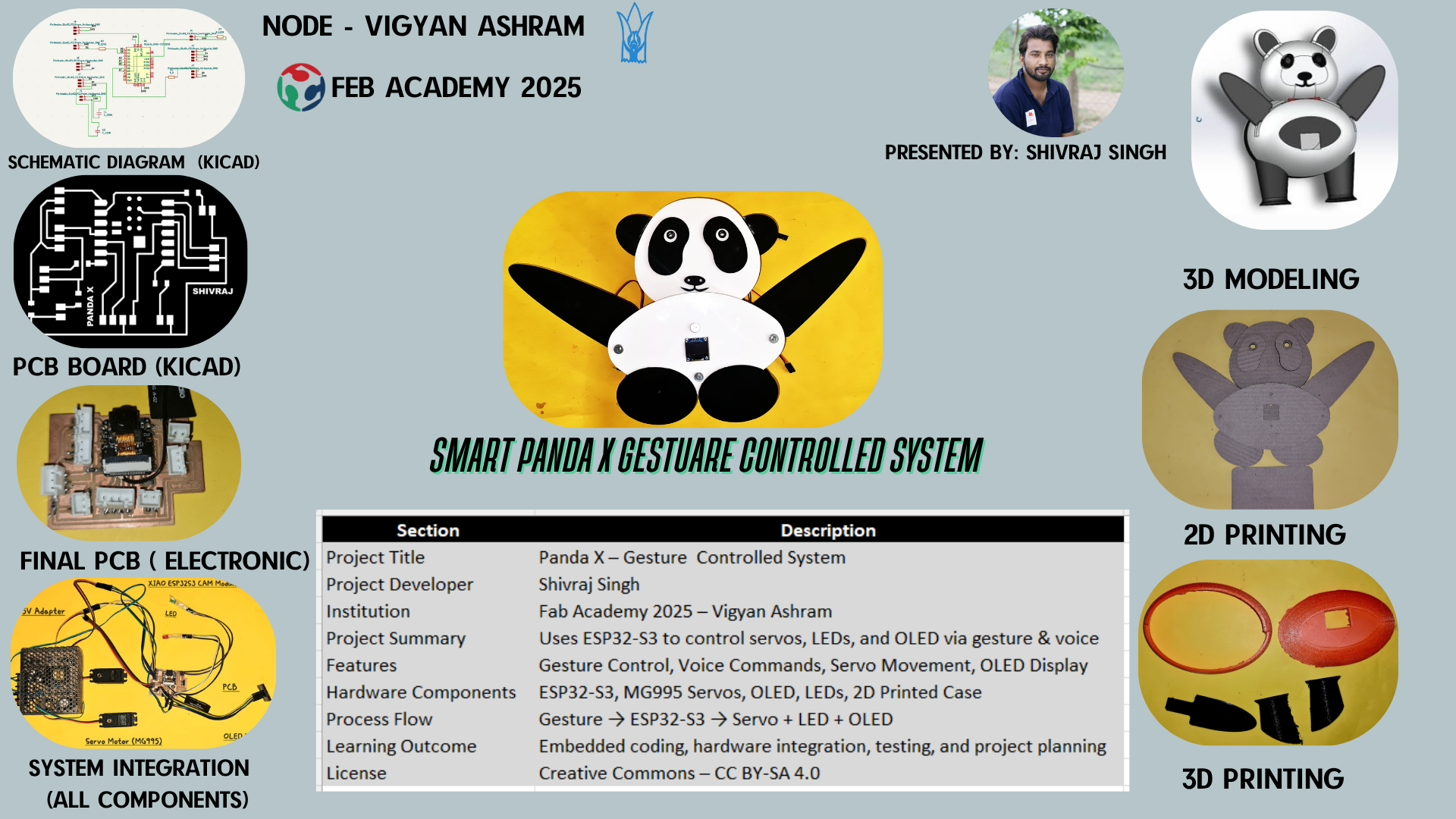Invention, Intellectual Property and Income
About this week
This week's topic was "Invention, Intellectual Property, and Income." We learned about innovation — which refers to a new invention or an improvement to an existing one that can be useful to others. Innovation can be something entirely original or a meaningful enhancement of an existing idea or product.
We also learned how to create a license for our product to protect our rights and allow others to use it under certain conditions.
Additionally, we explored the concept of Intellectual Property (IP) — including how new inventions can be legally protected through patents, and the process involved in getting a patent. This knowledge is essential for anyone looking to commercialize their inventions and safeguard their creative work
Understanding the concept of invention
An invention is a unique or novel device, method, composition, idea or process. An invention may be an improvement upon a machine, product, or process for increasing efficiency or lowering cost. It may also be an entirely new concept.
If an idea is unique enough either as a stand-alone invention or as a significant improvement over the work of others, it can be patented. A patent, if granted, gives the inventor a proprietary interest in the patent over a specific period of time, which can be licensed for financial gain.
Introduction to Intellectual Property (IP)
Intellectual property (IP) is a category of property that includes intangible creations of the human intellect. There are many types of intellectual property, and some countries recognize more than others. The best-known types are patents, copyrights, trademarks, and trade secrets. The modern concept of intellectual property developed in England in the 17th and 18th centuries.
The term "intellectual property" began to be used in the 19th century, though it was not until the late 20th century that intellectual property became commonplace in most of the world's legal systems.
Types of Intellectual Property:-
Rights:- Intellectual property rights include patents, copyright, industrial design rights, trademarks, plant variety rights, trade dress, geographical indications, and in some jurisdictions trade secrets. There are also more specialized or derived varieties of sui generis exclusive rights, such as circuit design rights (called mask work rights in the US), supplementary protection certificates for pharmaceutical products (after expiry of a patent protecting them), and database rights (in European law). The term "industrial property" is sometimes used to refer to a large subset of intellectual property rights including patents, trademarks, industrial designs, utility models, service marks, trade names, and geographical indications.
Patents:- A patent is a form of right granted by the government to an inventor or their successor-in-title, giving the owner the right to exclude others from making, using, selling, offering to sell, and importing an invention for a limited period of time, in exchange for the public disclosure of the invention. An invention is a solution to a specific technological problem, which may be a product or a process, and generally has to fulfill three main requirements: it has to be new, not obvious and there needs to be an industrial applicability. 17 To enrich the body of knowledge and to stimulate innovation, it is an obligation for patent owners to disclose valuable information about their inventions to the public.
Copyright: - A copyright gives the creator of an original work exclusive rights to it, usually for a limited time. Copyright may apply to a wide range of creative, intellectual, or artistic forms, or "works".Copyright does not cover ideas and information themselves, only the form or manner in which they are expressed.
Industrial design rights: - Industrial design right (sometimes called "design right" or design patent) protects the visual design of objects that are not purely utilitarian. An industrial design consists of the creation of a shape, configuration or composition of pattern or color, or combination of pattern and color in three-dimensional form containing aesthetic value. An industrial design can be a two- or three-dimensional pattern used to produce a product, industrial commodity or handicraft. Generally speaking, it is what makes a product look appealing, and as such, it increases the commercial value of goods.
Plant varieties:-Plant breeders' rights or plant variety rights are the rights to commercially use a new variety of a plant. The variety must, amongst others, be novel and distinct and for registration the evaluation of propagating material of the variety is considered.
Trademarks:- A trademark is a recognizable sign, design or expression that distinguishes a particular trader's products or services from similar products or services of other traders.
Trade secrets:- Trade secret is a formula, practice, process, design, instrument, pattern, or compilation of information which is not generally known or reasonably ascertainable, by which a business can obtain an economic advantage over competitors and customers.
Trade secrets are protected by a combination of state and federal laws,[United States-centric] which prescribe a combination of civil and criminal penalties for trade secret “misappropriation”—the improper acquisition, disclosure, or use of a trade secret.
Dissemination Plan for panda x
1.Identification of Key Target Audiences:- The goal of the PandaX project is to support this mission by making learning more interactive and fun. PandaX will be used in these schools to engage children through emotion-based interaction. It will respond to their emotions and voice commands, helping them learn, play, and express themselves in a joyful way. This smart panda will become a friendly digital companion for students, making the classroom environment more exciting and supportive.
2. Strategic Plan for Product Launch and Promotion :- The Panda X project will be launched through my personal portfolio website, making it accessible to a wider audience including educators, students, and developers. To promote the project and gather practical feedback, I plan to conduct live demonstrations in schools, allowing students to interact with and experience the system firsthand.
3.Intellectual Property Protection through Licensing or Legal Safeguards :-To protect the intellectual property of the Panda X project while encouraging open innovation, I have choosen an open-source license. This license allows anyone to use, modify, and build upon the technology, as long as they follow the terms defined in the license.
By choosing an open-source approach, the project remains accessible to the community, enabling developers and learners to contribute improvements that could benefit others. This not only safeguards my rights as the creator but also supports knowledge sharing and collaborative growth in the tech ecosystem.
4. Pilot Implementation and Structured Feedback Collection :- This Project will be demonstrated in schools as a pilot program, where teachers, students, and other observers can experience the system in action. This setting will allow a diverse group of users to interact with the project and provide valuable feedback.
Collecting feedback from real users is a crucial part of the development process, as it helps identify areas for improvement and informs future planning. The insights gained during this phase will play an important role in enhancing the project’s functionality, usability, and overall impact.
5.Development of Educational and Training Materials :- To ensure the effective use of the Panda X project, I will provide educational and training materials for both teachers and students. These resources will explain how to properly operate the system, including how to position the device in classrooms or other suitable locations and how to start and interact with it.
A step-by-step guide will be created to help users understand the setup and functionality of Panda X, making the technology more accessible and user-friendly. These materials will play a key role in supporting learning, smooth implementation, and encouraging wider adoption of the project.
6. Impact Evaluation and Iterative Project Refinement :- After the Panda X project is used for a period of time, I will conduct feedback sessions involving teachers, students, and other participants. These sessions will help evaluate the real-world impact of the project—whether it is functioning as intended, how it is being used, and what improvements may be necessary.
Based on the feedback collected, I will identify any issues and implement necessary updates or enhancements to improve performance, usability, and user experience. This iterative process is essential to ensure the project continues to evolve and better meet user needs.
7. Future Roadmap and Opportunities for Project Expansion :- For future development, I plan to enhance the Panda X project by integrating Google Assistant, a built-in speaker system, and larger motors such as stepper motors to enable movement. Additionally, I will work on improving the overall design and functionality to make the system more interactive and engaging.
These advancements will not only improve the performance and appeal of Panda X but also increase its educational value. The goal is to make it a more powerful learning tool that can help students, children, and other users better understand emerging technologies like voice control, robotics, and automation.
Generating a Creative Commons license for the Final Project
To create the license, I used the Creative Commons website and began the license generation process. The complete step-by-step procedure is given below.
Website link here
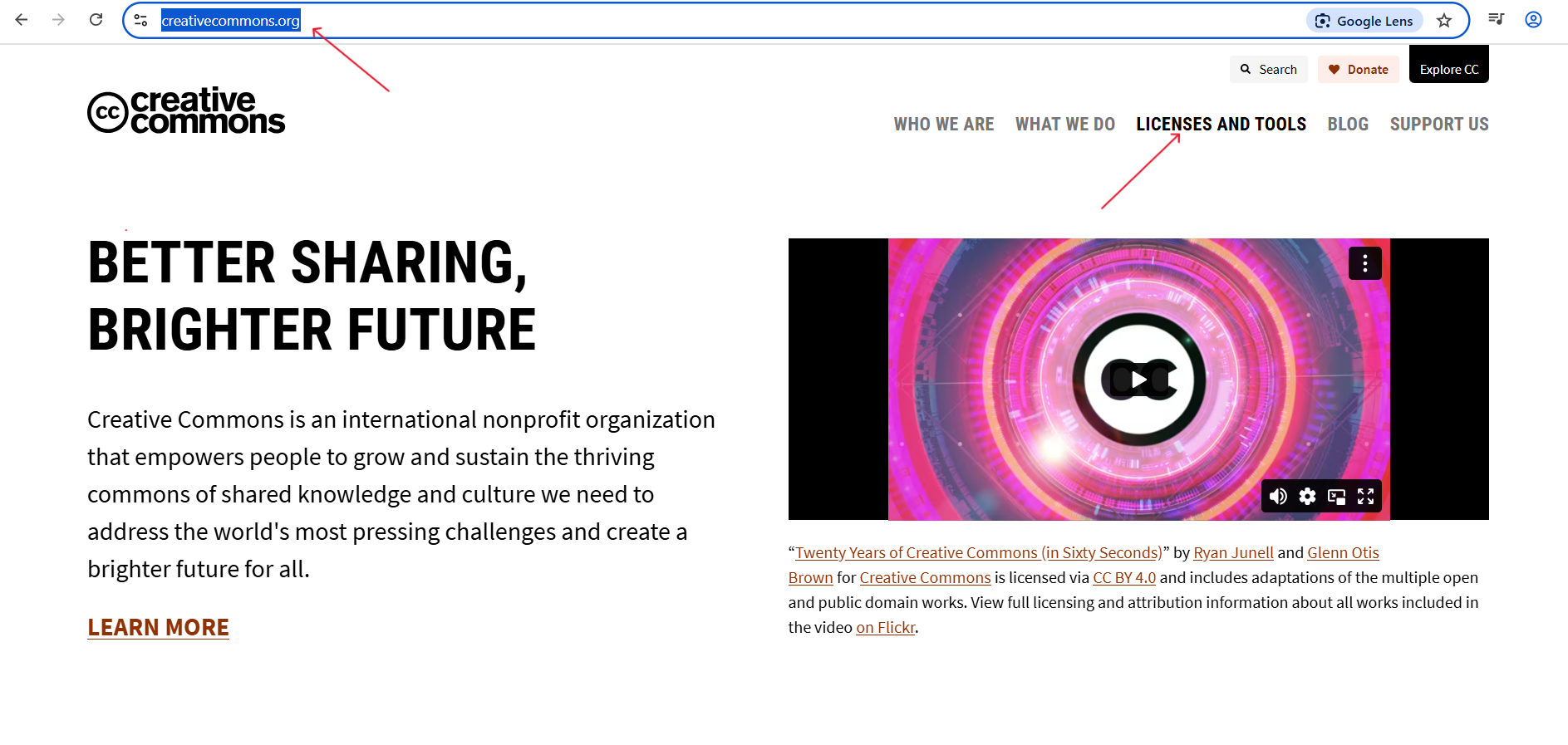
|
| First visit this "creativecommons.org website then click on "LICENSES AND TOOLS" option |
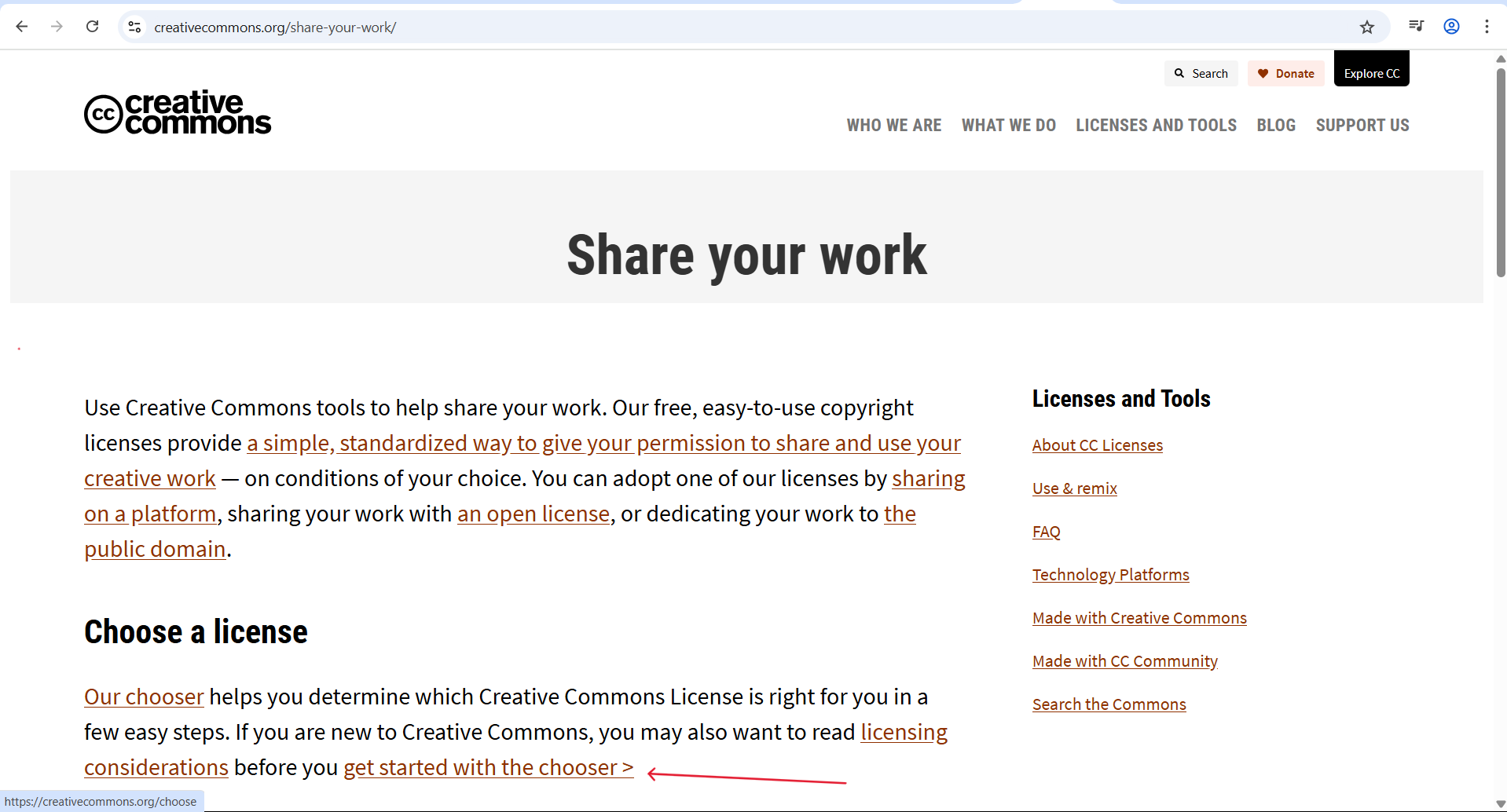
|
| Then scrol downand click on "get started with the chooser" option |

|
| As you can see, there are multiple questions listed —answer each of them one by one |

|
| Now click on check box and fill the the information required. |
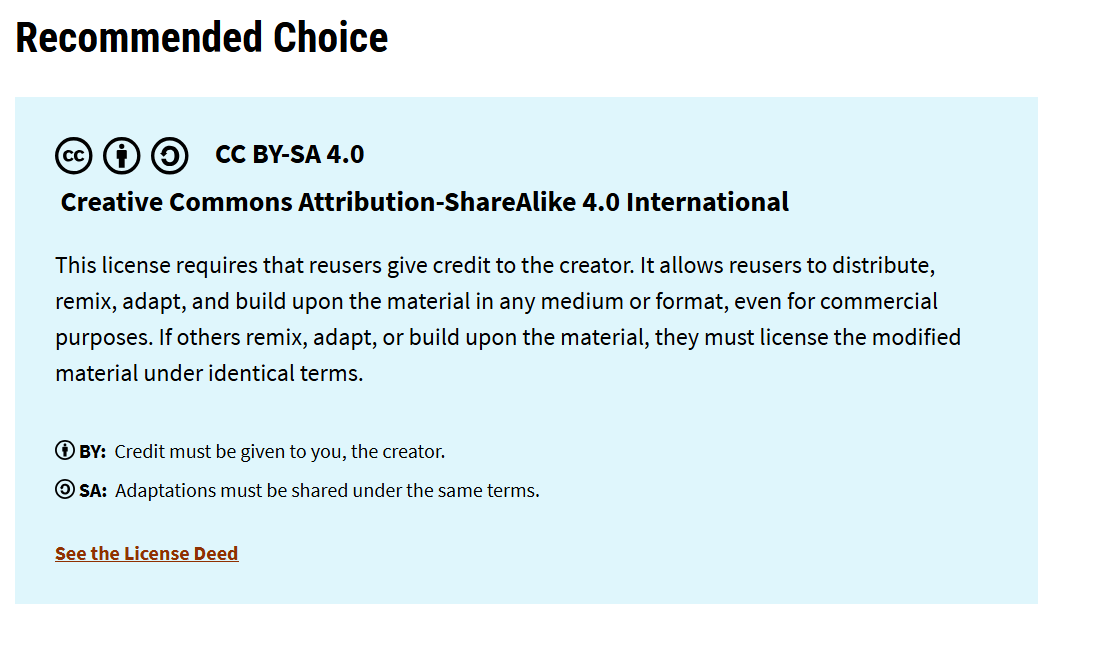
|
| After filling in the required information and selecting the checkbox, the license is successfully generated. |
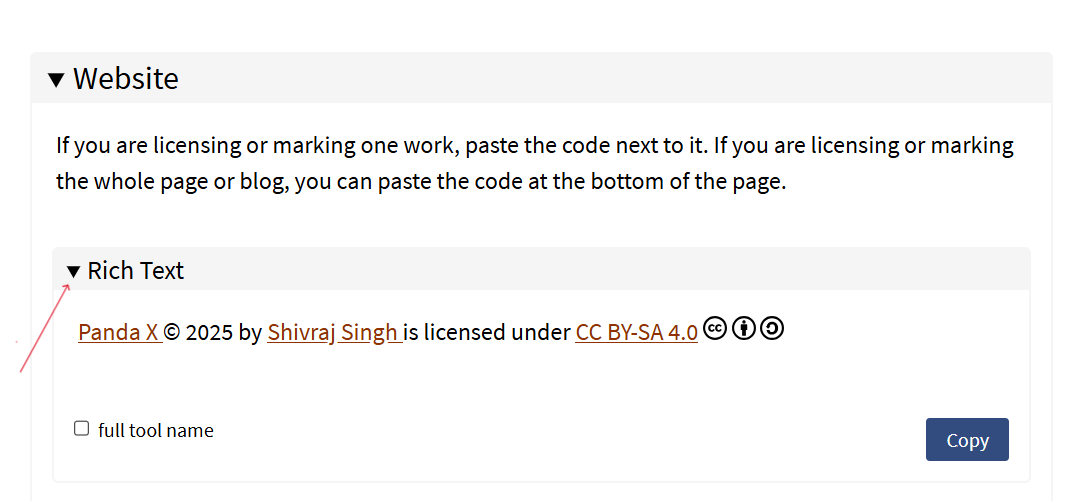
|
| Now, on the right side, you’ll see options for a website and rich text. Simply click on 'Rich Text' to view your license link, which you can easily copy and use. |
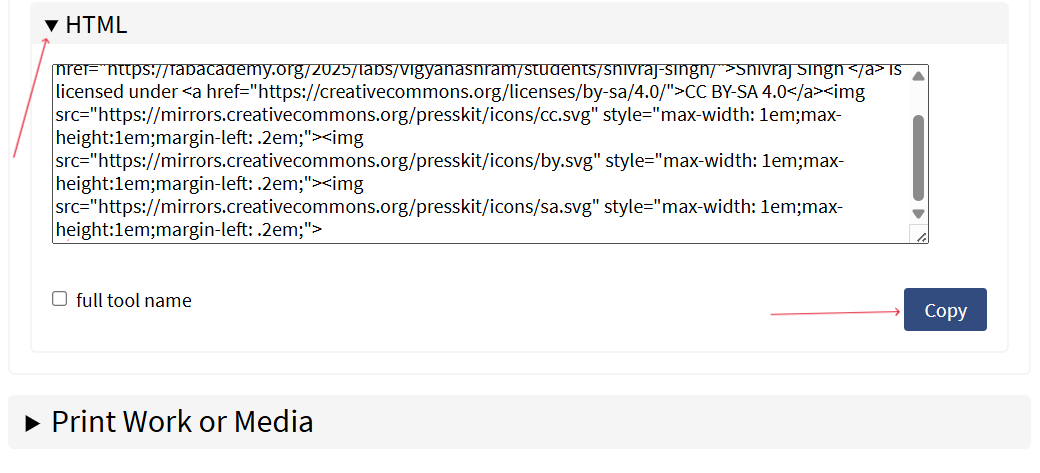
|
| Below the Rich Text option, you’ll find an HTML option. By clicking on it, you can copy the HTML code and paste it into your website’s HTML file to add the license directly to your site. |

|
| You can insert the copied HTML license code into the 'info section' of your HTML file as shown in this image. |

|
| Once the license HTML code is added to website HTML file, the license will appear on website—as you can see in the image. |
Project slide for presentation
Final Presentation Video
Summary
This week’s topic was “Invention, Intellectual Property, and Income.”
I learned about innovation, which means creating something new or improving an existing invention in a way that can benefit others. Innovation can either be an original idea or an enhancement that adds new value to existing products.
We also learned how to license our products so that others can use them legally and ethically under specific terms and conditions. I created an open-source license for my product using the Creative Commons website (link mentioned above) and added it to my own project website.
In addition, I explored the concept of Intellectual Property (IP), including how to patent an invention to protect it from unauthorized use. A patent ensures that others follow rules if they want to use or build upon the technology, encouraging fair and responsible innovation.
Conclusion & Learning Outcome
This week’s assignment helped me understand how innovation is not just about creating something new, but also about protecting and sharing it properly. I learned how to license my work and how intellectual property laws support inventors. These concepts are essential for anyone who wants to turn their creative ideas into useful, legal, and shareable products while ensuring their rights are protected.










